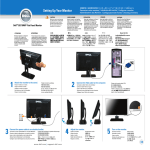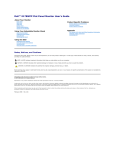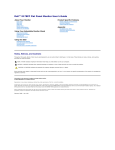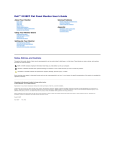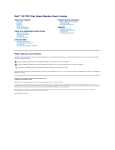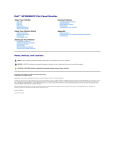Download Dell SE178WFP User's Manual
Transcript
Dell SE178WFP Flat Panel Monitor User's Guide
About Your Monitor
Front View
Back View
Side View
Bottom View
Monitor specifications
Caring for your Monitor
Using Your Adjustable Monitor Stand
Product Specific Problems
Monitor Specific Troubleshooting
Common Problems
Product Specific Problems
Appendix
FCC Notice (U.S. Only) and Other Regulatory Information
CAUTION: Safety Instruction
Contacting Dell
Attaching the Stand
Organizing Your Cables
Using the Tilt
Removing the Stand
Using the OSD
Connecting Your Monitor
Using the Front Panel Buttons
Using the OSD
Using the Dell Soundbar (Optional)
Notes, Notices, and Cautions
Throughout this guide, blocks of text may be accompanied by an icon and printed in bold type or in italic type. These blocks are notes, notices, and cautions,
and they are used as follows:
NOTE: A NOTE indicates important information that helps you make better use of your computer.
NOTICE: A NOTICE indicates either potential damage to hardware or loss of data and tells you how to avoid the problem.
CAUTION: A CAUTION indicates the potential for property damage, personal injury, or death.
Some warnings may appear in alternate formats and may be unaccompanied by an icon. In such cases, the specific presentation of the caution is mandated by
regulatory authority.
Information in this document is subject to change without notice.
© 2007 Dell Inc. All rights reserved.
Reproduction in any manner whatsoever without the written permission of Dell Inc. is strictly forbidden.
Trademarks used in this text: Dell, the DELL logo, Inspiron, Dell Precision, Dimension, OptiPlex, Latitude, PowerEdge, PowerVault, PowerApp, and Dell OpenManage are trademarks of
DellInc Microsoft and Windows are registered trademarks of Microsoft Corporation ENERGY STAR is a registered trademark of the U.S. Environmental Protection Agency. As an ENERGY
STAR partner, Dell Inc. has determined that this product meets the ENERGY STAR guidelines for energy efficiency.
Other trademarks and trade names may be used in this document to refer to either the entities claiming the marks and names or their products. Dell Inc. disclaims any
proprietary interest in trademarks and trade names other than its own.
April 2007 Rev. A00
Back to Contents Page
About Your Monitor
Dell SE178WFP Flat Panel Monitor User's Guide
Front View
Back View
Side View
Bottom View
Monitor Specifications
Caring for your Monitor
Front View
1
Menu selection button
2
Brightness Contrast / Down(-) button
3
Auto-Adjust / Up(+) button
4
Power On/Off button with LED indicator
Back View
1
Security lock slot
Attach a lock to secure your monitor.
2
Dell Soundbar mounting brackets
Attach the optional Dell Soundbar.
3
Barcode serial number label
Refer to this label if you need to contact Dell for technical support.
4
Regulatory rating label
List the regulatory approvals.
5
Stand removal button
Press to release the stand.
6
VESA mounting holes ( 100mm - behind
attached stand)
Use to mount monitor.
7
Cable holder
Help organize cables by passing them through the holder.
Side View
Right side
Left side
Bottom View
1
AC power cord connector
2
VGA connector
Monitor Specifications
General
Model number
SE178WFP
Flat Panel
Screen type
Active matrix - TFT LCD
Screen dimensions
17 inches (17-inch diagonal viewable image size)
Preset display area:
Horizontal
367.2 mm(14.46 inches)
Vertical
229.5 mm(9.04 inches)
Pixel pitch
0.255 mm x 0.255 mm
Viewing angle
Viewing angle 150° (vertical) typ, 160° (horizontal) typ(CR>10)
Luminance output
250 cd/m ²(typ)
Contrast ratio
600:1 (typ)
Faceplate coating
Glossy with hard-coating 2H
Backlight
2 CCFL backlight
Response Time
8 ms typical (Black to White)
Resolution
Horizontal scan range
30 kHz to 83 kHz (automatic)
Vertical scan range
50 Hz to 75 Hz
Optimal preset resolution
1440 x 900 at 60 Hz
Highest preset resolution
1440 x 900 at 60 Hz
Preset Display Modes
The following table lists the preset modes for which Dell guarantees image size and centering:
Display Mode
Horizontal Frequency
(kHz)
Vertical Frequency (Hz)
Pixel Clock (MHz)
Sync Polarity (Horizontal/Vertical)
VGA, 720 x 400
31.5
70.1
28.3
-/+
VGA, 640 x 480
31.5
60.0
25.2
-/-
VESA, 640 x 480
37.5
75.0
31.5
-/-
VESA, 800 x 600
37.9
60.3
40.0
+/+
VESA, 800 x 600
46.9
75.0
49.5
-/+
VESA, 1024 x 768
48.4
60.0
65.0
-/-
VESA, 1024 x 768
60.0
75.0
78.8
+/+
VESA, 1152 x 864
67.5
75.0
108.0
+/+
VESA, 1280 x 1024
64.0
60.0
108.0
+/+
VESA, 1280 x 1024
80.0
75.0
135.0
+/+
55.935
60.0
106.5
-/+
VESA, 1440 x 900
Electrical
The following table lists the electrical specification:
Video input signals
Analog RGB: 0.7 Volts +/-5%, 75 ohm input impedance Synchronization input signals
D-sub: Detachable, Analog, 15pin, shipped attached to the monitor
AC input voltage / frequency / current
100 to 240 VAC / 50-60 Hz / 0.6A (100V)& 0.35A(240V)Max.
Inrush current
120V: 30A (Max.)
240V: 60A (Max.)
Physical Characteristics
The following table lists the physical characteristics:
Signal cable type
D-sub: Detachable, Analog, 15pin, blue connector, attached to the
monitor
Dimensions (with stand):
Height
Width
Depth
339.2 mm (13.35 inches)
403.2 mm (15.87 inches)
126.2 mm (4.97 inches)
Weight:
Monitor (Stand and Head)
Monitor Flat panel only (VESA Mode)
Weight with packaging
3.86 kg ( 8.49 lb)
2.70 kg (5.95 lb)
5.31 kg (11.68 lb )
Environmental
The following table lists the environmental limitation:
Temperature:
Operating
Nonoperating
5° to 35 °C (41° to 95 °F)
Storage: 0° to 60 °C (32° to 140 °F)
Shipping: -20° to 60 °C (-4° to 140 °F)
Humidity:
Operating
Nonoperating
10% to 80% (noncondensing)
5% to 90% (noncondensing)
Altitude:
Operating
3,657.6 m (12,000 ft) max
Nonoperating
12,192 m ( 40,000 ft ) max
Thermal dissipation
256.08 BTU/hour (maximum)
119.5 BTU/hour (typical)
Power Management Modes
If you have VESA's DPMS compliance display card or software installed in your PC, the monitor automatically reduces its power consumption when not in use.
This is referred to as Power Save Mode. If input from keyboard, mouse or other input devices is detected by the computer, the monitor automatically resumes
functioning. The following table shows the power consumption and signaling of this automatic power-saving feature:
Power Management Definition
VESA's Mode
Video
H-sync
V-sync
Power Used
ON
Active
Yes
Yes
maximum 40W
Power Saving
Blanked
No
Yes
Blanked
Yes
No>
Blanked
No
Blanked
--
Power Saving
LED color
0%
Blue
<=2W
>80%
Amber
<=2W
>80%
Amber
No
<=2W
>80%
Amber
--
<=1W
>80%
Off
typical 34W
Switch Off
NOTE: The OSD functions only in the normal operation mode. Otherwise one of the following
messages will appear depending upon the selected input.
In Power Save Mode
Press computer power button
or any key on keyboard or move mouse
Activate the computer and the monitor to gain access to the OSD.
Pin Assignments
VGA Connector
The following table shows pin assignments in the VGA connector:
Pin
Number
15-pin Side of the
Connected Signal Cable
1
Video-Red
2
Video-Green
3
Video-Blue
4
GND
5
Self-test
6
GND-R
7
GND-G
8
GND-B
9
Computer 5V/3.3V
10
GND-sync
11
GND
12
DDC data
13
H-sync
14
V-sync
15
DDC clock
Plug and Play Capability
You can install the monitor in any Plug and Play-compatible system. The monitor automatically provides the computer system with its Extended Display
Identification Data (EDID) using Display Data Channel (DDC) protocols so the system can configure itself and optimize the monitor settings. Most monitor
installations are automatic; you can select different settings, if required.
LCD Monitor Quality & Pixel Policy
During the LCD Monitor manufacturing process, it is not uncommon for one or more pixels to become fixed in an unchanging state. The visible result is a fixed
pixel that appears as an extremely tiny dark or bright discolored spot.
In almost every case, these fixed pixels are hard to see and do not detract from display quality or usability. A display with 1 to 5 fixed pixels is considered
normal and within competitive standards. For more information, see Dell Support site at: support.dell.com.
Caring for your Monitor
CAUTION: Read and follow the Safety Instruction before cleaning the monitor.
CAUTION: Before cleaning the monitor, unplug the monitor from the electrical
outlet.
l
l
l
l
l
To clean your antistatic screen, slightly dampen a soft, clean cloth with water. If possible, use a special screen-cleaning tissue or solution suitable for
the antistatic coating. Do not use benzene, thinner, ammonia, abrasive cleaners, or compressed air.
Use a slightly-dampened, warm cloth to clean the plastics. Avoid using detergent of any kind as some detergents leave a milky film on the plastics.
If you notice a white powder when you unpack your monitor, wipe it off with a cloth. This white powder occurs during the shipping of the monitor.
Handle your monitor with care as darker-colored plastics may scratch and show white scuff marks more than lighter-colored monitor.
To help maintain the best image quality on your monitor, use a dynamically changing screen saver and power off your monitor when not in use.
Back to Contents Page
Back to Contents Page
Appendix
Dell SE178WFP Flat Panel Monitor User's Guide
FCC Notice (U.S. Only) and Other Regulatory Information
CAUTION: Safety Instruction
Contacting Dell
FCC Notice (U.S. Only) and Other Regulatory Information
For FCC Notice and other regulatory information, see the regulatory compliance website located at www.dell.com\regulatory_compliance.
CAUTION: Safety Instructions
For information on safety instructions, refer to your Product Information Guide.
Contacting Dell
For customers in the United States, call 800-W W W-DELL (800-999-3355).
NOTE: If you do not have an active Internet connection, you can find contact information on your purchase invoice, packing slip, bill, or Dell product
catalog.
Dell provides several online and telephone-based support and service options. Availability varies by country and product, and some services may not be
available in your area. To contact Dell for sales, technical support, or customer service issues:
1.
2.
3.
4.
5.
Visit support.dell.com .
Verify your country or region in the Choose A Country/Region drop-down menu at the bottom of the page.
Click Contact Us on the left side of the page.
Select the appropriate service or support link based on your need.
Choose the method of contacting Dell that is convenient for you.
Back to Contents Page
Back to Contents Page
Setting Up Your Monitor
Dell SE178WFP Flat Panel Monitor User's Guide
Connecting Your Monitor
Using the Front Panel Buttons
Using the OSD
Using the Dell Soundbar (Optional)
Connecting Your Monitor
CAUTION: Before you begin any of the procedures in this section, see the Safety Instructions.
1.
2.
3.
4.
5.
Turn off your computer and unplug its power cable.
Connect the blue (analog D-sub) display connector cable to the corresponding video port on the back of your computer. (The graphic is for illustration
only. System appearance may vary).
Connect the power cable for your display to the power port on the back of the display.
Plug the power cables of your computer and your display into a nearby outlet. Your monitor is equipped with an automatic power supply for a voltage
range from 100 to 240 Volt at a frequency of 50/60 Hz. Be sure that your local power is within the supported range. If you are unsure, ask your
electricity supplier.
Turn on your display and computer.
If your monitor displays an image, installation is complete. If it does not display an image, see Troubleshooting.
Using the Front Panel Buttons Use the control buttons on the front of the monitor to adjust the characteristics of the image being displayed. As you use these buttons to adjust the controls,
an OSD shows their numeric values as they change.
The following table describes the front panel buttons:
A
The 'MENU' button is used to open the on-screen display (OSD), select function icons, exit from menus and sub-menus, and to exit the OSD. See
Accessing the Menu System.
MENU
B
Use this button for direct access to the 'Brightness' and 'Contrast' control menu.
Brightness/Contrast Hot
Key
B
C
Use these buttons to adjust (decrease/increase ranges) items in the OSD.
NOTE: You can activate automatic scroll feature by pressing and holding either + or - button.
- and + buttons
C
Use this button to activate automatic setup and adjustment. The following dialog will appear on screen as the monitor self-adjusts to the current
input:
Auto adjustment In Progress.
Auto Adjust
Auto Adjustment
button allows the monitor to self-adjust to the incoming video signal. After using 'Auto Adjustment', you can further tune your
monitor by using the 'Pixel Clock' and 'Phase' controls in the OSD.
NOTE: Auto Adjust will not occur if you press the button while there are no active video input signals, or attached cables.
D
The Blue LED indicates the monitor is on and fully functional. An amber LED indicates DPMS power save mode. The Power button turns the monitor on and off.
Power Button &
Indicator
On Screen Menu/Display (OSD)
Direct-Access Functions
Function
Adjustment Method
Auto adjustment
Use this button to activate automatic setup and adjustment. The following dialog will appear on
screen as the monitor self-adjusts to the current input:
Auto adjustment In Progress
Auto Adjustment
button allows the monitor to self-adjust to the incoming video signal. After
using 'Auto Adjustment', you can further tune your monitor by using the 'Pixel Clock' and 'Phase'
controls in the OSD.
NOTE: Auto Adjust will not occur if you press the button while there are no active video input
signals, or attached cables.
Brightness / Contrast
With the menu off, press
button to display the 'Brightness' and 'Contrast' adjustment menu.
The 'Brightness' function adjusts the luminance of the flat panel.
Adjust 'Brightness' first, then adjust 'Contrast' only if further adjustment is necessary.
"+" increase 'brightness'
" - "decrease 'brightness'
The 'Contrast' function adjusts the degree of difference between darkness and lightness on the
display screen. "+" increase the 'contrast'
"-" decrease the 'contrast'
Using the OSD
Accessing the Menu System
1.
2.
3.
4.
Icon
With the menu off, press the MENU button to open the OSD system and display the main features menu.
A
Function icons
B
Main Menu
D
Sub-Menu name
E
Resolution
C
Menu icon
Press the - and + buttons to move between the function icons. As you move from one icon to another, the function name is highlighted to reflect the
function or group of functions (sub-menus) represented by that icon. See the table below for a complete list of all the functions available for the monitor.
Press the MENU button once to activate the highlighted function. Press -/+ to select the desired parameter, press menu to enter the slidebar
then use the - and + buttons, according to the indicators on the menu, to make your changes.
Press the MENU button once to return to the main menu to select another function or press the MENU button two or three times to exit from the OSD.
Menu Name
and Submenus
Description
EXIT
This is used to exit out of the Main Menu.
Positioning:
'Positioning' moves the viewing area around on the monitor screen.
Horizontal When making changes to either the Horizontal or Vertical settings, no changes occur to the size of the viewing area; the image gets
Vertical shifted based on what you select.
Minimum is '0' (-). Maximum is '100' (+).
Image
settings:
Auto Adjust Even though your computer system can recognize your new flat panel monitor on startup, the 'Auto Adjustment' function will optimize
the display settings for use with your particular setup.
NOTE: In most cases, 'Auto Adjust' produces the best image for your configuration; you can directly access this function via Auto Adjustment
hotkey. Pixel Clock The Phase and Pixel Clock adjustments allow you to more closely adjust your monitor to your preference. Select Image Settings in
the main OSD to access these settings. Use the - and + buttons to adjust interference. Minimum: 0 ~ Maximum: 100
Phase If satisfactory results are not obtained using the Phase adjustment, use the Pixel Clock adjustment and then use Phase again.
NOTE: This function may change the width of the display image. Use the 'Horizontal' function of the 'Position' menu to center the display image on the screen.
Color
Settings:
Adjusts the color temperature and saturation.
Color Settings adjust the color temperature.
Color Settings has the following options: Color Management :
Color Settings Mode : You can choose between a Graphics and a Video mode. If your computer is connected to your monitor, choose
Video.
Color Presets: You can choose different color presets for different viewing modes.
As soon as choose Graphics,you can choose Normal Preset, Red Preset,Blue Preset or User Preset.
Select Red Preset for a warm color.
Select Blue Preset for a cool color.
You can adjust the monitor color using User Preset, R, G, B.Normal Preset mean color temperature 6500K.
Select Blue Preset for a bluish tint. This color setting is used for text based applications (spreadsheets, programming, text editors,
etc.).
Select Red Preset for a reddish tint.This color setting is used for color-intensive applications (photograph image editing, multimedia,
movies, etc.).
Select Normal Preset for default color settings. This setting is also the “sRGB” standard default color space.
User Preset: Use the plus and minus buttons to increase or decrease each of the three colors (R, G, B) independently, in single digit
increments, from 0 to 100.
There are three video modes:Theater Preset ,Sports Preset, Nature Preset.
Select Theater Preset for playing a movie.
Select Sports Preset for viewing sports.
Select Nature Preset for general viewing. For general picture or web or watch TV, choose Nature Preset.
User can adjust the Hue(Tint)/Saturation based on the preference.
NOTE: 'Color temperature' is a measure of the 'warmth' of the image colors (red/green/blue). The two available presets ('Blue' and
'Red') favor blue and red accordingly. Select each one to see how each range suits your eye; or utilize the 'User Preset' option to
customize the color settings to your exact choice.
OSD
Settings:
Each time the OSD opens, it displays in the same location on the screen. 'OSD Settings' (horizontal/vertical) provides control over this
location.
Horizontal - and + buttons move OSD to the left and right.
Position
Vertical - and + buttons move OSD down and up.
Position
OSD Hold The OSD stays active for as long as it is in use.
Time: 'OSD Hold Time': Sets the length of time the OSD will remain active after the last time you pressed a button.
Use the - and + buttons to adjust the slider in 5 second increments, from 5 to 60 seconds.
NOTE: Default 'OSD hold time' is 20 seconds.
OSD Lock Controls user access to adjustments. When 'Yes' (+) is selected, no user adjustments are allowed. All buttons, except Menu, are
locked.
All buttons can be locked or unlocked. Press the 'Menu' button for over 15 seconds to unlock the OSD menu. NOTE: When the OSD is locked, pressing the 'Menu' button will take the user directly to the 'OSD settings' menu, with 'OSD Lock'
preselected on entry. Select 'No'(-) to unlock and allow user access to all applicable settings.
Language:
Language sets the OSD to display in one of the five languages (English, Español, Français, Deutsch, Japanese).
NOTE: The language chosen affects only the language of the OSD. It has no effect on any software running on the computer.
Factory
Reset:
Factory Reset returns the settings to the factory preset values for the selected group of functions.
Exit is used to exit out of Factory Reset menu.
For All settings, all user adjustable settings are reset at one time except Language settings.
IR — This feature helps reduce minor cases of image retention.
Enable LCD Conditioning: If an image appears to be stuck on the monitor, select LCD Conditioning to help eliminate any image
retention. Using the LCD Conditioning feature may take several hours. Severe cases of image retention are known as burn-in, the
LCD Conditioning feature does not remove burn-in.
NOTE: Use LCD Conditioning only when you experience a problem with image retention.
Below warning message appears when you select “Enable LCD Conditioning”:
NOTE: Press any button on the monitor to terminate LCD Conditioning at any time.
DDC/CI (Display Data Channel/Command Interface) allows you to adjust the monitor parameters (brightness, color, balance, etc.) via software applications on your PC. Select Disable to disable this feature.
For best user experience and optimum performance of your monitor, keep this feature enabled. NOTE:If you select 'disable' for DDC/CI,the warning message appears on screen.You can select Yes or No according to need.
Automatic Save
With the OSD open, if you make an adjustment and then either proceed to another menu, or exit the OSD, the monitor automatically saves any adjustments
you have made. If you make an adjustment and then wait for the OSD to disappear the adjustment will also be saved.
OSD Warning Messages
A warning message may appear on the screen indicating that the monitor is out of sync.
Cannot Display This Video Mode
Optimum resolution 1440 x 900 60Hz
This means that the monitor cannot synchronize with the signal that it is receiving from the computer. Either the signal is too high or too low for the monitor to
use. See Specifications for the Horizontal and Vertical frequency ranges addressable by this monitor. Recommended mode is 1440 X 900 @ 60Hz.
NOTE: The floating 'Dell - self-test Feature Check' dialog appears on the screen if the monitor cannot sense a video signal.
Occasionally, no warning message appears, but the screen is blank. This could also indicate that the monitor is not synchronizing with the computer.
See Troubleshooting for more information.
Using the Dell Soundbar (Optional)
The Dell Soundbar is a stereo two channel system adaptable to mount on Dell Flat Panel Displays. The Soundbar has a rotary volume and on/off control to
adjust the overall system level, a blue LED for power indication, and two audio headset jacks.
1.
Power/Volume control
2.
Power indicator
3.
Headphone connectors
Soundbar Attachment to the Monitor
1.
Working from the rear of the monitor, attach the Soundbar aligning the two slots with the two tabs along the bottom rear of the monitor.
2.
Slide the Soundbar to the left until it snaps into place.
3.
Connect the Soundbar with the power brick.
4.
Plug the power cable of the power brick into a nearby outlet.
5.
Insert the lime-green mini stereo plug from the rear of the Soundbar into the computer's audio output jack.
NOTICE: Do not use with any device other than Dell Soundbar. NOTE: Soundbar Power Connector - 12V DC output is for optional Dell Soundbar only.
Back to Contents Page
Back to Contents Page
Product Specific Problems
Dell SE178WFP Flat Panel Monitor User's Guide
Monitor Specific Troubleshooting
Common Problems
Product Specific Problems
CAUTION: Before you begin any of the procedures in this section, follow the Safety Instructions.
Monitor Specific Troubleshooting
Self-Test Feature Check (STFC)
Your monitor provides a self-test feature that allows you to check whether your monitor is functioning properly. If your monitor and computer are properly
connected but the monitor screen remains dark, run the monitor self-test by performing the following steps:
1.
2.
3.
Turn off both your computer and the monitor.
Unplug the video cable from the back of the computer. To ensure proper Self-Test operation, remove the Analog (blue connector) cables from the back of
computer.
Turn on the monitor.
The floating 'Dell - Self-Test Feature Check' dialog box should appear on-screen (against a black background) if the monitor cannot sense a video
signal and is working correctly. While in self-test mode, the power LED remains blue. Also, depending upon the selected input, one of the dialogs
shown below will continuously scroll through the screen.
4.
5.
This box also appears during normal system operation if the video cable becomes disconnected or damaged.
Turn off your monitor and reconnect the video cable; then turn on both your computer and the monitor.
If your monitor screen remains blank after you use the previous procedure, check your video controller and computer system; your monitor is functioning
properly.
OSD Warning Messages
For OSD-related issues, see OSD Warning Messages
Common Problems
The following table contains general information about common monitor problems you might encounter.
COMMON SYMPTOMS
No Video/ Power LED off
WHAT YOU EXPERIENCE
No picture, monitor is dead
POSSIBLE SOLUTIONS
l
l
l
No Video/ Power LED on
No picture or no brightness
l
l
l
Poor Focus
Picture is fuzzy, blurry or ghosting
l
l
Press Auto Adjust button
l
l
Wavy picture or fine movement
Increase brightness & contrast controls
Perform monitor self-test feature check
Check for bent or broken pins
Press Auto Adjust button
Adjust Phase and Clock controls through OSD
Eliminate video extension cables
Perform monitor reset
Lower video resolution or increase font size
l
l
Shaky/Jittery Video
Check connection integrity at both ends of the video cable
Electric outlet verification
Ensure power button depressed fully
l
l
l
l
Missing Pixels
LCD screen has spots
l
l
Stuck-on Pixels
LCD screen has bright spots
l
l
Brightness Problems
Picture too dim or too bright
l
l
l
Geometric Distortion
Screen not centered correctly
l
l
l
l
Horizontal/Vertical Lines
Screen has one or more lines
l
l
l
l
l
Sync Problems
Screen is scrambled or appears
torn
l
l
l
l
l
l
LCD Scratched
Screen has scratches or smudges
l
l
Safety Related Issues
Visible signs of smoke or sparks
l
l
Intermittent Problems
Monitor malfunctions on & off
l
l
l
l
Missing Color
Picture missing color
l
l
l
Wrong Color
Picture color not good
l
l
Image Retention (from a
static image) Faint Shadow from the static image
displayed appears on the screen
l
l
Adjust Phase and Clock controls through OSD
Perform monitor reset
Check environmental factors
Relocate and test in another room
Cycle power on-off
These are pixels that are permanently off and is a natural defect that occurs in LCD
technology
Cycle power on-off
These are pixels that are permanently on and is a natural defect that occurs in LCD
technology
Perform monitor reset on "All Settings"
Press Auto Adjust button
Adjust brightness & contrast controls
Perform monitor reset on "Position Settings Only"
Press auto-adjust button
Adjust the centering controls
Ensure monitor is in proper video mode
Perform monitor reset on "All Settings"
Press Auto Adjust button
Adjust Phase and Clock controls via OSD
Perform monitor self-test feature check and determine if these lines are also in selftest mode
Check for bent or broken pins
Perform monitor reset on "All Settings"
Press Auto Adjust button
Adjust Phase and Clock controls via OSD
Perform monitor self-test feature check to determine if scrambled screen appears in
self-test mode
Check for bent or broken pins
Boot up in the "safe mode"
Turn monitor off and clean the screen
For cleaning instruction, see Caring for your Monitor.
Do not perform any troubleshooting steps
Monitor needs to be replaced
Ensure monitor is in proper video mode
Ensure video cable connection to computer and to the flat panel is secure
Perform monitor reset on "All Settings"
Perform monitor self-test feature check to determine if the intermittent problem
occurs in self-test mode
Perform monitor self-test feature check
Check connection integrity at both ends of the video cable
Check for bent or broken pins
Change the color to "User Preset"
Adjust R/G/B value of "User Preset"
Use the Power Management feature to turn off the monitor at all times when not in
use. Alternatively, use a dynamically changing screensaver left on the monitor for a long period of time.
In OSD Menu, under Reset to Factory Settings, select Enable LCD Conditioning.
Using this option may take several hours before the image is eliminated.
NOTE: Image Burn-in is not covered by your warranty.
Product Specific Problems
SPECIFIC SYMPTOMS
WHAT YOU EXPERIENCE
Screen image is too small
Image is centered on screen, but does not
fill entire viewing area
POSSIBLE SOLUTIONS
l
Perform monitor reset on "All Settings"
Cannot adjust the monitor
with the buttons on the
front panel
OSD does not appear on the screen
l
Turn the monitor off and unplug the power cord and
then plug back and power on
The monitor will not go into
power saving mode.
No picture, the LED light is blue. When
press "+", "-" or "Menu" key, the message
" No input signal " will appear.
l
Move mouse or hit any key on the keyboard on the
computer or activate video player, then access the OSD to set both Audio/Video to " off " state.
No Input Signal when user
controls pressed
No picture, the LED light is blue. When
press "+", "-" or "Menu" key, the message
" No input signal " will appear.
l
l
l
OSD Lock
Back to Contents Page
All buttons are locked except the "menu"
button. No user adjustments are allowed.
l
Check the signal source Make sure the Computer is
not in power saving by moving mouse or pressing
any key on the keyboard.
Check whether the signal cable is plugged in and
seated properly. Re-plug the signal cable if
necessary.
Re-boot the computer or video player.
Press the "menu" button for over 15 seconds to
unlock the OSD menu.
Back to Contents Page
Using Your Monitor Stand
Dell SE178WFP Flat Panel Monitor User's Guide
Attaching the Stand
Organizing Your Cables
Using the Tilt
Removing the Stand
Attaching the Stand
NOTE: Stand is detached when the monitor is shipped from the factory.
1. Place the stand on a flat surface.
2. Fit the groove on the back of the monitor onto the two tabs of the upper stand.
3. Lower the monitor so that the monitor mounting area snaps on/locks to the stand.
Organizing Your Cables
After attaching all necessary cables to your monitor and computer, (See Connecting Your Monitor for cable attachment,) use the cable holder to
neatly organize all cables as shown above.
Using the Tilt
With the stand, you can tilt the monitor to best suit your viewing needs.
Removing the Stand
After placing the monitor panel on a soft cloth or cushion, press and hold the stand removal button, and then remove the stand.
NOTE: To prevent scratches on the LCD screen while removing the stand, ensure that the monitor is placed on a clean
surface.
Back to Contents Page
























